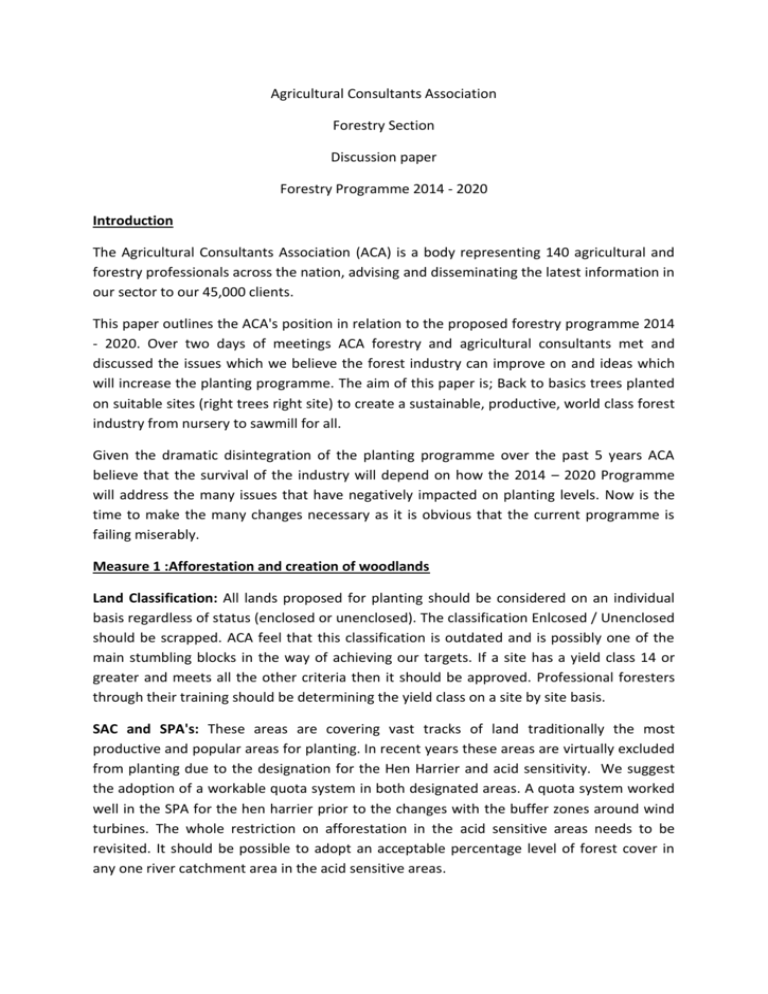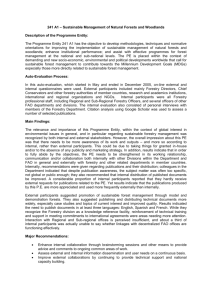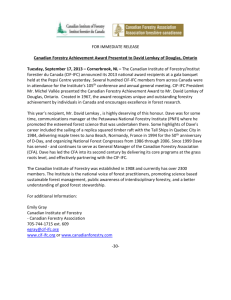Agricultural Consultants Association
advertisement

Agricultural Consultants Association Forestry Section Discussion paper Forestry Programme 2014 - 2020 Introduction The Agricultural Consultants Association (ACA) is a body representing 140 agricultural and forestry professionals across the nation, advising and disseminating the latest information in our sector to our 45,000 clients. This paper outlines the ACA's position in relation to the proposed forestry programme 2014 - 2020. Over two days of meetings ACA forestry and agricultural consultants met and discussed the issues which we believe the forest industry can improve on and ideas which will increase the planting programme. The aim of this paper is; Back to basics trees planted on suitable sites (right trees right site) to create a sustainable, productive, world class forest industry from nursery to sawmill for all. Given the dramatic disintegration of the planting programme over the past 5 years ACA believe that the survival of the industry will depend on how the 2014 – 2020 Programme will address the many issues that have negatively impacted on planting levels. Now is the time to make the many changes necessary as it is obvious that the current programme is failing miserably. Measure 1 :Afforestation and creation of woodlands Land Classification: All lands proposed for planting should be considered on an individual basis regardless of status (enclosed or unenclosed). The classification Enlcosed / Unenclosed should be scrapped. ACA feel that this classification is outdated and is possibly one of the main stumbling blocks in the way of achieving our targets. If a site has a yield class 14 or greater and meets all the other criteria then it should be approved. Professional foresters through their training should be determining the yield class on a site by site basis. SAC and SPA's: These areas are covering vast tracks of land traditionally the most productive and popular areas for planting. In recent years these areas are virtually excluded from planting due to the designation for the Hen Harrier and acid sensitivity. We suggest the adoption of a workable quota system in both designated areas. A quota system worked well in the SPA for the hen harrier prior to the changes with the buffer zones around wind turbines. The whole restriction on afforestation in the acid sensitive areas needs to be revisited. It should be possible to adopt an acceptable percentage level of forest cover in any one river catchment area in the acid sensitive areas. Farmer status: The ACA welcome the proposed scrapping of the farmer rate of premium and welcome a one premium for all. Netting of payments: Currently netting of payments is taken from the establishment grant usually mandated to the registered forester. We propose the netting should not be taken from the Grant. The Grant is not an income payment but a capital payment for works done. The premium payment is income and is the more appropriate source for any netting. Other Agricultural schemes At present there are interaction issued between forestry and other agriculture schemes e.g. the Disadvantage Area Base scheme. The ACA suggest that the new forestry scheme must be fullly compatible with all other agriculture schemes especially the proposed new GLAS scheme. As with FEPS and REPS, applicants planting under the new forestry scheme, planting 5 hectares or more should automatically qualify for GLAS. GPC The ACA welcome the two new proposed forestry GPC's agro-forestry and forestry for fibre. In relation to the GPC's we suggest a less complicated categorisation of payments. Instead of having the current 8 GPC's and expanding this to 10, we suggest a 4 GPC's system. GPC 1 Conifer GPC 2 Broadleaves (including NWS Establishment) GPC3 Agro-forestry GPC 4 Forestry for fibre Grants and Premium: The 12 year premium duration as outlined is likely to impact on the planting targets in a negative manner. We suggest that the 20 year premium remains. The longer the payment period the less the impact will be felt. Currently the establishment and maintenance grants are paid, 75% year 1 and the remaining 25% in year 4. We suggest in year 1, a 70% payment be made and in years 2 and 3 a further payment of 10% each year and the final 10% paid in year 4 following a successful forest service inspection. The reason for this suggestion is that the grant payments will reflect the timing of costs incurred. It is suggested that payments 1 and 4 be subject to Forest Service inspection but that 2 and 3 will be paid automatically. If the plantation is not up to the required standard two year's after the second inspection is due premium payments may stop. Also for some species e.g. Norway spruce and some other species the establishment period should be extended to 6 years and if the standards are not met in a further 2 years then payments can stop. All fencing with an allowance for gates should be paid on a per meter / unit basis. At approval stage the total meters and number of gates and the specification should be agreed and approved upon. Grant and premium rates To reach the 10,000 - 15,000 hectares per annum target the levels of grants and premium will need to be revaluated. At current grant aid levels the industry is seeing a massive drop in the planting programme month on month. In 2020, if the real living costs continue to rise at approximately 3% per annum this will lead to an 18% decrease in the value of the premium over the life of the programme. The ACA suggest increasing the grants and premiums to the following. Afforestation Grants rates GPC 1 Conifer: € 4,290 /Ha GPC 2 Broadleaves (including NWS Establishment): €6,500 / ha GPC3 Agro-forestry: TBA GPC 4 Forestry for fibre: TBA Fencing: rate per meter based on specification erected When calculating afforestation grants VAT should not be excluded as it is the statutory requirement of all persons and entities to make an individual VAT return. Afforestation Premium Rates GPC 1 Conifer: € 590 /Ha GPC 2 Broadleaves (including NWS Establishment and conservation): €670 / ha GPC3 Agro-forestry: TBA GPC 4 Forestry for fibre: TBA Appeals system The current appeals system we believe needs to be reformed. Currently there are issues with delays in decisions, a lack of impartiality and transparency. This process needs to have strict guidelines applied in relation to the length of time for a decision. The panel adjudicating on the issues needs to be balanced with independent representation and have a clear and transparent decision making process. Administration process To improve the entire administration process the ACA suggest the current IFORS system be upgraded to improve efficiency, reduce costs and cut the time that each application requires. For iFORIS to be fit for purpose it needs to be 100% electronic which is not the case at present. At Form 1 stage an electronically submitted Form 1 should go to the Forest service inspector directly. There should be no necessity to digitise at this stage as there are no payment implications. The system should automatically refer applications if deemed necessary to the relevant bodies once the fully completed application is submitted. At form 2 stage the mapping done using the system and approved by the forest services inspector should be taken as correct and should not be superseded by future and better technology on that individual plantation. Legal and Taxation Over the past 5 years land ownership issues at form 2 stage have become a real issue for the industry. Ownership registration formats and legal technicalities have left many applicants and foresters waiting length periods before payment. This area of the forestry process should be reformed and brought inline with all other agriculture schemes, otherwise it will erode confidence in the whole forestry programme thus impacting on our planting targets. Currently the tax free allowance for forestry is €80,0000 this needs to be changed to a more equitable income averaging to reflect the long term investment in the forest over the total rotation of 35 to 45 years. Measure 2: Investements in infrastructure: Forest road scheme The Forest road is an essential part of any forestry plantation and the forest road scheme allows the state and growers to maximise the return from their forestry investment. Under the current scheme the specification for roads can not be met by the level of grant currently available. The ACA suggest that the harvesting road specification is correct, but the level of funding needs to be increased to take into account the rising cost of labour and materials and time required by the forester. At road side there is a much higher cost per meter and this needs to be taken into account. Also special construction works needs to be included in any new scheme. A second road specification should be considered for modified harvesting equipment to accessing plantations. The 80% 20% payment schedule needs to be reverted back to the original 100% payment on completion of the road. When calculating road grants VAT should not be excluded as it is the statutory requirement of all persons and entities to make an individual VAT return. Completion dates on projects; need to be flexible to accommodate different road construction techniques, environmental restrictions and weather conditions. Measure 3 Reconstitution scheme The reconstitution scheme in its current format is primarily used to recover a forest’s potential after it has suffered damaged through disease, adverse weather and damage from vermin. The current scheme does not provide any assistance in the case of fire and windblow. The assumption that insurance is obtainable by all forest owners is flawed especially with recent widespread windblow that has occurred across the country. Currently no forest owners are able to get windblow insurance after the storm on the 12 th of February. The reconstitution scheme needs to be expanded to meet with the current climate and to ensure that potential and current forest owners will have a sufficient safety net for the afforestation scheme. Grant aid must provide assistance for damage from the following: Frost, Deer, Squirrel, Beetle, Windblow, Fire, As per the afforestation and road scheme, the costs associated with VAT should not be excluded as it is the statutory requirement of all persons and entities to make an individual VAT return. Unlike the afforestation scheme, reconstitution of a plantation incurs greater costs. Therefore the maximum grant rate level must take this into consideration. Measure 4 Neighbour Wood Scheme This scheme is designed to increase the economic, environmental and social value of forestry in Ireland. This scheme is welcomed by the ACA and will support its extension. Measure 5 Thining and Tending of Broadleaves This scheme is required to ensure the productivity of current broadleaf plantations. It is vital to ensure that the management and cultivation of these sites is preserved as a well tended crop will be much more valuable in the future. The scheme however does not at present cover some of the basic management needs of a plantation and this needs to be looked at. Funding is required to promote the establishment of management paths and tracks within these plantations. These are required to manage the site correctly as well as for future applications of fertilizer if they are required. Measure 6 Native Woodland Scheme The ACA agrees with the measure to ensure the continuation of the Native Woodland Scheme. With the greater environmental objectives being put forward by the European Union, we must look at diversifying the way in which we plant forestry. This scheme helps to ensure that. The ACA would also approve the re-introduction of the conservation element. The native woodlands of Ireland are important heritage and environmentally significant sites. These sites are not currently being maintained as there is no incentive on any owner of natural woodland to sustain or protect these sites. The reintroduction of the conservation element will help promote and encourage people to protect these nationally valuable sites. Measure 7 Knowledge Transfer and Information Actions The ACA fully support the creation of knowledge transfer groups. The ACA currently has 45000 clients nationally, therefore we have access to a vast number of clients who would be interested and gain real value from these groups. With over 140 consultants registered we are able to distribute the knowledge garnered efficiently and effectively to all our members on a 1 to 1 or through group sessions. The ACA consultants hold such meetings on a daily basis as part or their regular duties. The ACA support the measure to require registered foresters to be a part of a professional association which has a continuous professional development programme. The ACA already has a programme in place to foster the development of all aspects of the forestry programme and would welcome a chance to expand upon it once adequate funding was available. The ACA suggest a continual professional development programme be introduced in the format of a bi-annually forestry meetings including all forest service inspectorate and approved foresters, this will aid in better communication and standardising of works nationally. In relation to the knowledge transfer groups, the facilitator will be required to manage, understand and lead these discussion groups therefore a Level 7 degree in forestry would at least be required. The facilitator should also be paid directly by the forest Service. Target training is an important measure and requires funding. For forest owners the focus of the training should be on Chainsaw use, First Aid, Occupational First Aid, Manual handling, timber measurement and the use of chemicals. Measure 8 Setting up Producer Groups The ACA is in favour of this objective. The funding for this should be in direct correlation with the amount of timber that each group is producing. There also needs to be strict criteria on what this funding may be used for. Measure 9 Investments in Forest Technology The technology used within the forest industry is advancing at a rapid pace, therefore the ACA welcomes this measure to invest in the future. The funding should be made available to forestry consultants who are one of the first to utilize such technologies. Furthermore this measure would need to be linked in directly with Measure 7. It would be fundamental to ensure that those receiving money for developing or training in the use of new technologies, pass on the knowledge they acquire to other parties and individuals within the forestry industry. Measure 10 Forest Environment and Climate Services The ACA believe that this is an important measure that does indeed require funding. Conifers should be included within this measure. The focus of this measure is towards the sustainable development of Ireland’s seed production. Measure 11 Forest Management Plans Management plans are required to ensure that the forestry plantations are being managed correctly and that they will generate high quantity and quality of product into the future. The costs associated with forest management plans will vary depending on the size, species and quality of the plantation. Funding should be considered for the creation of inspection paths, as detailed in Measure 4 for broadleaf schemes, for all plantations. This will enable the forester to generate a management plan of much greater detail and accuracy. All sites, regardless of the size, should have a management plan and the level of funding should be in relation to the varying factors that influence the cost of the plan. END








